
In his will of June 13, 1669, Rochus Lochner of Huettenbach transferred half of the Huettenbach manor to his son Liborius and his grandson John George Lochner of Huettenbach at Lintach in Upper Palatinate, as heirs of his eldest son George Frederick – that’s how it has been common in Franconia at that time.

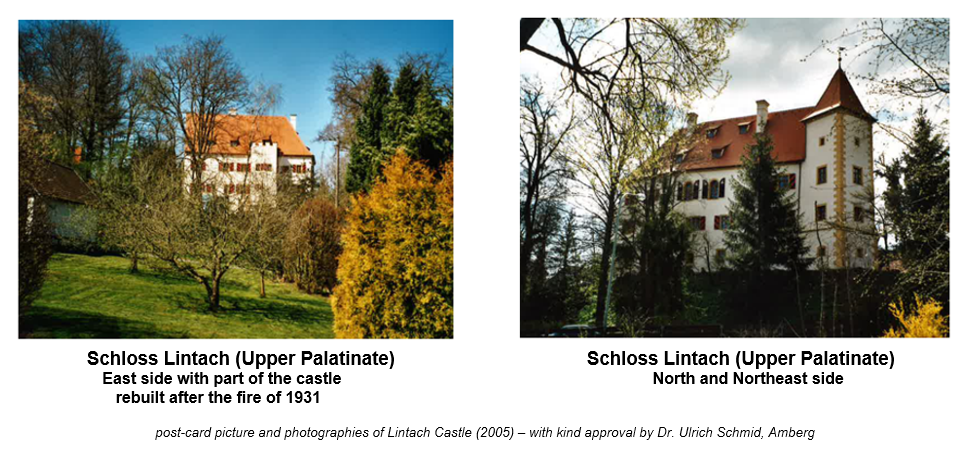
John George sold his share of these inheritance claims to his uncle Liborius on February 7, 1679 for 5,000 fl. and 100 “Imperial talers”. Conversely, his sister Sophia Susanna, who has married to Bohemia, namely Henry Lothar Winkler of Hainfeld at Schlackenwerth (whose ancestor has been a mercenary companion of Conrad Lochner of Liebenfels around 1460), sells her brother’s share on Lintach manor (German: Hofmark = lordship over land and subjects) near the town of Amberg in Upper Palatinate on May 18, 1681 for 2,000 fl. and 50 fl. loan purchase.
John George Lochner of Huettenbach weds Maria Sophia Joana of Sparneck in 1688, and he is mentioned in 1712 when the tithe has been awarded by Emperor Charles VI, the father of the famous Empress Maria Theresia (House of Habsburg). In 1746 he hires a school teacher in Lintach taking over his salary. He finds his final resting place in the family crypt in front of the presbytery of the Lintach Church, and he has been immortalized there on the altarpiece from 1741. The Lochner of Huettenbach at Lintach finances this church from their own resources in 1735, as evidenced by existing church accounts, that is why they naturally exercise the right of patronage[1]. They have once been able to acquire this right for 1,500 florins from Kastl Monastery. However, his “splendid idea as a patron” to have the right that on Sundays the church service should only begin when HE intends to arrive, has immediately been denied by the government of Upper Palatinate. There are numerous memorial plaques for deceased members of the family on the inside and outside of the church. The oratory, where the lordship attends the service, is only subsequently furnished in 1805, and the coat-of-arms of the Lochner of Huettenbach proudly displays above the high altar:
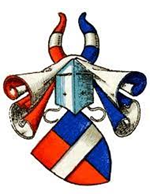

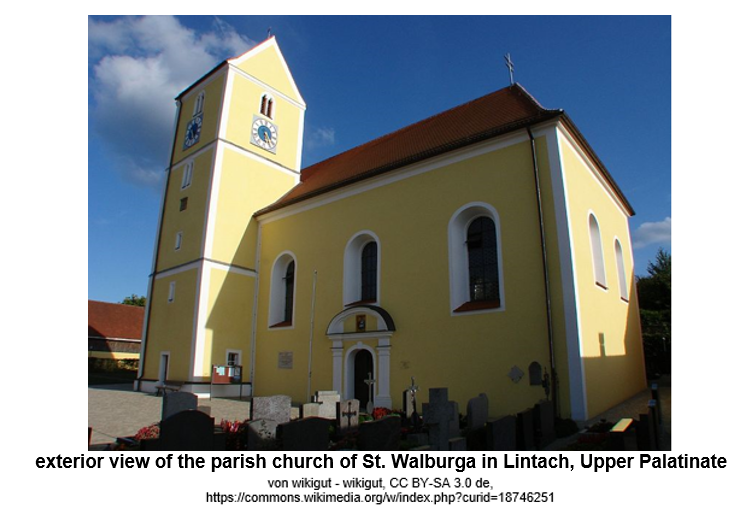


With his son John Christoph Anthony and his sister Maria Sophia Susanna (married to Wolfgang Albrecht of Freudenberg), this line will expire in 1753. Another four sisters, whose name order always begins with Maria as their first name, impressively demonstrates the successful re-catholicization of the population by the Elector of Bavaria in Upper Palatinate. In his will dated May 5, 1753, he names his sister’s son, John Henry of Freudenberg, Electoral Bavarian chamberlain and captain, who has been chosen to be the Lord of the “Hofmark Lintach” and owner of the house in Amberg as “estate in tail male”[2] – if he will have no descendants, inheritance goes to his cousin Carl Christoph Louis Lochner of Huettenbach, of the Lindenberg line, who is in relationship with his cousin Sophia Barbara Lochner of Huettenbach, a daughter of Christoph Henry.
In Huettenbach, Liborius‘ eldest son from his marriage to Anna Maria of Aufsess, Christoph Henry Lochner of Huettenbach (May 16, 1662 – February 20, 1743), has now taken over the manor. He initially serves in the Electoral Palatinate-Bavarian regiment from 1675 to 1682, becomes a “royal Bamberg Captain-Lieutenant” and Deputy commander of the Rosenberg fortress near Kronach (today’s Upper Franconia). Afterwards he is a senior medieval bailiff in Fuerth upon Berg (in the Coburg district) and around 1700 a curator in Vilseck town in Upper Palatinate. As he knows Upper Palatinate’s conditions from his own experience, he acquires the “Hofmark of Theuern” (a village 9 km south of Amberg) on May 3, 1727 for 28,000 fl. It is awarded to him as a fief on January 26, 1728. His private life has been less stringent: his first wife Sidonie Justina of Herda will die in childbirth in Kronach in 1694 and their daughter soon follows her in death – certainly a bitter pill for a young man in his early 30s. His second wife, Juliane Sophie Marschall of Ostheim, whom he marries in 1696, will die less than 10 years later in Vilseck in 1708. Of their 9 children, only a few will reach adulthood. The only surviving son of this marriage, Rudolph Henry (May 15, 1699 – November 9, 1739), like his half-brother Carl Derrick later in 1745, will take a young lady of the noble Zollner of Brand family as his wife in 1735, so namely Miss Amalia Christiana (born December 4, 1707).

This Zollner of Brand[3] family is a Patrician family from Bamberg, which also forms a branch in the Free Imperial city of Nuremberg in the 13th century. From 1402 to 1471 they are even represented in the so-called “Inner Council” of Nuremberg and can be traced back to 1543. They are enrolled as knights of the Franconian nobility – but oddly enough: until the 1550s they will force to litigate with the Bishop of Bamberg for the recognition of their noble status! The last Zollners extinct by the end of the 18th century[4].
For a third time in 1709, Christoph Henry marries Renate Maria Dorothea of Freudenberg in Vilseck, who will survive her husband by seven years. Another five sons and six daughters come from this connection. He is serving in Vilseck for the old age of 81, even by today’s standards a very long life, and is buried in the Egidi Church there in 1743.

The respected and rich family of the Lords of Freudenberg should be examined in more detail: they come from the eponymous town of Freudenberg, today a municipality in the Upper Palatinate district of Amberg-Sulzbach, and are an old Bavarian noble family. From 1250 to 1594 the Imperial-free aristocratic estate of the Lords of Freudenberg has existed, who is being sold to the Palatinate Princes in Amberg by the last male of his family in Freudenberg, John II.-
When the inheritance will be divided on March 22, 1744, after the death of their father Christoph Henry Lochner of Huettenbach, another reason becomes apparent why he has acquired Theuern manor: his son Joseph Christian Lochner of Huettenbach (June 19, 1714 – October 22, 1789 ), who is in a relationship with Anna Eleonora Maria of Podewils since 1741, takes over this knightly manor with higher and lower jurisdiction. So the Amberg government enfeoffs him in 1743. His wife is the daughter of Christoph Erdmann Baron of Podewils at Diessfurt and Friedersreuth (near Pressath in Upper Palatinate) and brings 3,500 florins to marriage, which is given a son and three daughters.

The Barons of Podewils[5] are a noble family from Western Pomerania with the ancestral home of Podewils (today Podwilcze) in the former Prussian district of Belgard. The family spread greatly, initially as “Pudwels herb Pudwels” (Podewils with Podewils‘ coat-of-arms) to Poland and the Duchy of Prussia, later also to the March of Brandenburg, to Mecklenburg, Holstein and Denmark, as well as to the Principality of Bayreuth, the Bavarian land of Upper Palatinate and finally to Wuerttemberg. Branches of the family still exist today[6].-
Joseph Christian Lochner of Huettenbach becomes a Court and Government Councilor in the service of the Wuerzburg Bishop Frederick Carl of Schoenborn, has been Wuerzburg’s Steward from 1746 and Privy Councilor in 1757. Starting in 1780, he erects the stately in size Castle in Theuern with 64 windows for his son in French style as a noble residence. After the fortissimo of baroque spatial creations and the festive scherzo of the rococo, the art of the late 18th century ends in a very quiet and noble way. The construction of the aristocratic residence has involved an enormous cost of 20,000 florins. This places a great burden on both the lordship’s side and the subjects who are obliged to perform forced labor[7].
The three-story building increases in height (28 m) thanks to the characteristic mansard roof. This divided roof shape, is named after the French architect Francois Mansart, with a steeper lower half and a flat upper half, and has the purpose of accommodating another floor in the roof with almost vertical outer walls. On the Eastern long side (22 m) there is a slightly projecting structure (central projection) with a triangular gable. Here you can find the Lochner-Bibra marital coat-of-arms and the inscription: “If God does not help build the house, the builders help in vain” (1st verse of the 126th Psalm)”[8].
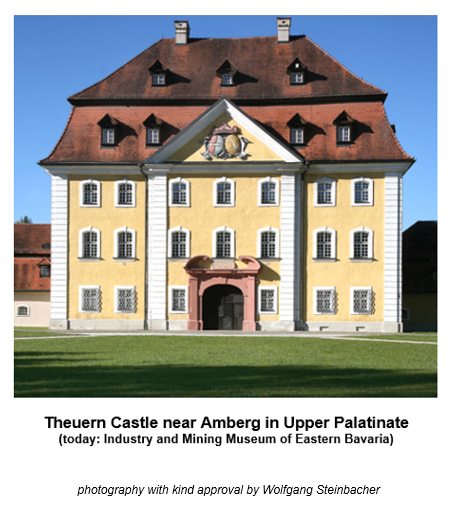
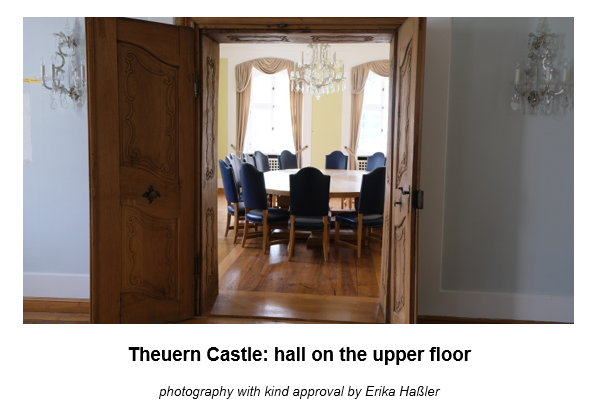
“The master builder, Wolfgang Diller from Amberg, has been won. As early as the 1870s, farm buildings (cattle stables and sheds) have been built, creating a four-wing complex around an enclosed inner courtyard. Inside, a “salon” on the first floor with carved Rococo doors has been preserved from the former room decoration next to the staircase with richly carved railings (see below)“[9].


The Barons of Bibra[10] are of Franconian nobility. The family’s seat Bibra upon Bibra river, is now a district of the municipality of Grabfeld, in the Schmalkalden-Meiningen district, in the Free State of Thuringia. The brothers John Ernest, Christian Erhard, George Frederick and Henry Carl have received the baron status from Emperor Leopold I through a diploma dated August 3, 1698.
The various lines of the family are registered in the Baron Class of the Bavarian Nobility Register in 1815 – and in the following years. There are still three castles to be owned by the Bibra, so Bibra Castle, as well as Irmelshausen and Brennhausen. The latter two moated castles in Franconia are particularly worth seeing and are often shown in calendars and illustrated books. Bibra Castle is the castle in Thuringia with the longest continuous ownership by a family since records began. Many members of this family now live in Australia and the USA[11].-
Joseph Christian’s younger brother Carl Derrick Lochner of Huettenbach (December 17, 1722 – February 9, 1770), however, as already reported, takes Maria Joana Franziska as his wife on October 6, 1745. He serves in the Bavarian army and comes into the possession of Huettenbach in 1744, i.e. from this generation onwards the Lochner of Huettenbach line has returned to Catholicism not only in Upper Palatinate, but also in Franconia. In 1750 he also comes into the co-ownership of Riegelstein[12] manor by inheritance. He invests enormous expenses in building a new Huettenbach Castle in 1760 – perhaps to be seen as a “competition between the brothers”. In 1766 he will call himself an Electoral Bavarian and Bamberg Chamberlain, Councilor at the war court and in 1768 Colonel and Commander of the Rosenberg fortress near Kronach, like his father Christoph Henry before him. From 1760 he has been a recipient of the Order of the Knights of St. George. This was the highest order of the nobility of the Electorate and later the Kingdom of Bavaria. His marriage remains childless. So it will happen that his brother Joseph Christian, now Lord of both manors, Theuern and Huettenbach, donates a commemorative plaque decorated with a coat-of-arms placed above the entrance gate of the Huettenbach Castle[13] in gratitude (see below).
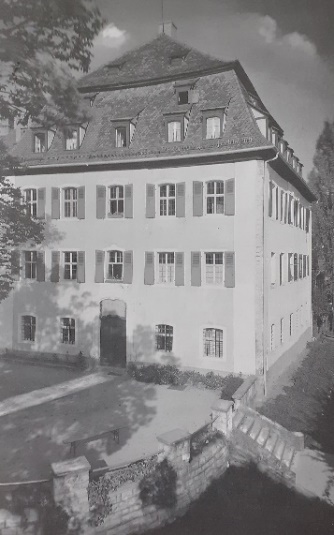
In 1787, Joseph Christian hands over Theuern to his son Frederick Ferdinand (May 8, 1747 – March 18, 1804) in a partition agreement. First of all, he is a noble boy at the Bishop’s court in Wuerzburg, and at the age of 24 he is already a Court Councilor and Court Cavalier – after less than five years later, a Chamberlain, then Senior Bailiff (medieval) firstly in Homburg upon Main and afterwards in Rothenfels upon Main in 1789. As a “Secret Councilor” he receives the title “Excellence” and – when Rothenfels has passed to Prince Loewenstein after secularization in 1802 – he has retired. Since 1779 he has been married to Josefa Maria Charlotte of Bibra, who brings with her 10,000 florins in assets (see above). Then, after the death of the eldest of the family, Carl Christoph Louis Lochner of Huettenbach, on October 27, 1795, Frederick Ferdinand, as the senior family boss, will also inherit the entailed estate of Lintach. There are now four little children at home: the son Franz Louis (May 18, 1780 – July 20, 1809) and three sisters. Frederick Ferdinand is already ill in May 1797, having visited Carlsbad in Bohemia and Alexandersbad (Wunsiedel district) several times, and since July 1802 he has no longer been able to use his right hand as a result of a fall from horse. He ends his life two years later. After deducting debts and unpaid bills, his wealth amounts to 37,000 florins, of which his son Franz Louis will receive ¾ and his sisters will each receive 1/12.
On August 4, 1806, Franz Louis‘ wedding to Baroness Antoinette of Verger is celebrated with great pomp in Theuern. 50 riflemen march out with guns, firecrackers are set off, the school children pay homage and music plays to the rich table.
But fate strikes on July 20th, 1809 the distinguished Lord will die in Amberg at the age of 29, and on August 1st his wife gets a son, Christian Adam Louis, but breathes out life shortly afterwards. An obelisk in the choir of the parish church in Theuern commemorates the last male of the Lochners in Theuern, which has been erected by the widow in 1810 in loving memory of her husband and child.
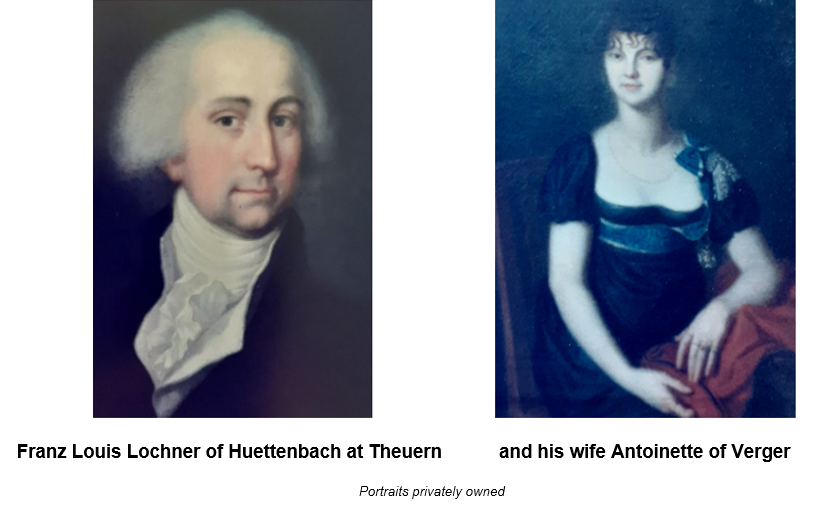
Theuern has now become the property of the three sisters. During the subsequent inheritance disputes, Count Herman of Hirschberg, who has been in a relationship with Sophie Lochner of Hüttenbach since 1806, takes over now the management of the estate. In 1811, Theuern is called “Royal Bavarian, Count of Hirschberg and Baron of Lochner patrimonial court”. The following year, the two sisters-in-law marry in Theuern and on April 28, 1814 the older one named Lucretia sells her Theuern share to her husband, State Councilor Carl Christian of Mann in Munich, who will also acquire the shares of his two sisters-in-law on September 15 and 17, 1816. Thereby becomes the sole owner of Theuern manor, which has belonged to the Lochner family for around 90 years.
What is to be said about this honorable man Carl Christian of Mann called Tiechler[14] (December 9, 1773 – March 22, 1837)? He is a German lawyer and in 1818 editor of the magazine „Eos – a magazine from Bavaria, for amusement and instruction“, which he will publish in the following years. He studies law at various universities and, after completing his studies, has been employed in the public service as a real Court Councilor in 1794. In 1799 he is appointed Auditor and in 1807 he has promoted to trainee lawyer in the Secret Ministerial Justice Department. As such, in 1808, he is deputed as a member of the advisory commission to discuss the introduction of the penal code to be intended.
In 1816 he is appointed President of the Court of Appeal for the Isar District in Munich. In this position he is also appointed State Councilor in extraordinary service and receives the title “Excellence”. Shortly afterwards he will become State Councilor in regular service in 1822. When the Court of Appeal is to be moved to Landshut in 1826, King Louis I appoints him Vice President of the Court of Appeal in Munich. In 1837 he has been elected to the Chamber of Deputies of the Assembly of Estates by the noble landowners in the Isar district. From the 4th electoral term on, he is chairman of the committee for the investigation of complaints from February 17, 1837.
He has married Lucretia Lochner of Huettenbach on October 26, 1812. They have a son together: Maximilian Christian Louis Chevalier of Mann Noble of Tiechler (born April 10, 1847 in Theuern), royal Bavarian Chamberlain and retired Captain (most recently at the Infantry Regiment No. 4 in Metz, France).
The king awards to Carl Christian of Mann called Tiechler the Knight’s Cross of the Order of Merit of the Bavarian Crown, and later the Commander’s Cross.
• He was a member of the Historical Association for Upper Palatinate and Regensburg.
A eulogy for him is given in the club by the pastor and dialect poet Kaspar Deml (1808 – 1883).
• He is on the board of the Polytechnic Association in Bavaria.
• He is an accepted member of the Bavarian Academy of Sciences.-
In Lintach, on the other hand, the old knightly family lasts much longer. After the Freudenberg’s death in 1755 (see above), since male „descendance“ is missing, Carl Christoph Louis Lochner of Huettenbach, who, like his uncle Christoph Henry, has been a Bambergian official in Vilseck, follows as „secundus vocatus“ and, in 1746, weds his cousin Sophie Barbara. In 1764 he will call himself Lord of Lintach, Lindenberg and Riegelstein. His son Franz Anthony (? – March 9, 1793), being Electoral Cologne Chamberlain, Bamberg Court Cavalier and Lieutenant of the Life Guard in 1790, will – according to the testimony of the Imperial Princess and Abbess Maria Franziska Josepha of Freudenberg (death in 1775 – mother: née Lochner of Lintach) – ensure, he is the candidate for the entailed estate of Lintach.
In 1790 Franz Anthony appoints his father Carl Christoph Louis and his cousin Christian Adam Lochner of Huettenbach at Lindenberg and Riegelstein as heirs. The latter is the son of Philipp Marquard and his wife Sophie of Buseck, a grandson of Christoph Louis, the younger son of Liborius George Sebastian Lochner of Huettenbach. Franz Anthony’s father, however, because he has also been sickly, gives Lintach „as long as he will be alive“ to Christian Adam at Kaibitz for 1,000 florins in 1791. That man makes a very special match with Maria Amalia Carolina Augusta Franziska de Paula, Countess of Holnstein from Bavaria (1775–1864), because she is supposedly “married into the provinces because of improper behavior”.
Her father, Franz Ludwig von Holnstein (October 4, 1723 – May 22, 1780) is a Bavarian count, general and illegitimate, but legitimate son of Elector or Emperor Karl Albrecht of Bavaria (House of Wittelsbach – see below).
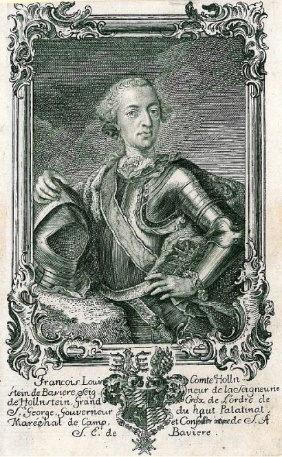
On October 4, 1728, Franz Louis is officially recognized by his father under the surname Count of Holnstein from Bavaria. He is the first of this new noble family, but his descendants do not belong to the House of Wittelsbach, but do receive their coat-of-arms with a so-called bastard bar. He is the illegitimate son from a love affair between Elector Prince Carl Albrecht of Bavaria and the Lady-in-waiting Maria Caroline Charlotte of Ingenheim and from the same liaison, he also has his sister Maria Josepha Comtesse de Hochenfels de Bavière, born in 1720, who has wedded her father’s general and half-brother in 1736, Emmanuel-François-Joseph Comte de Bavière (1695–1747). In 1723, three days before her birth, the mother married Carl Albrecht, the Electoral Chamberlain, and later Chief Lieutenant Field Marshal, Count Hieronymus of Spreti. With him she has 14 children in 26 years of marriage.
Count Franz Ludwig von Holnstein receives best education at Ettal monastery and then embarks on a military career. In the War of the Austrian Succession, he initially acts as Commander of a regiment, from October 1742 as Adjutant General to Field Marshal Frederick Henry of Seckendorff. In 1753, as Sergeant General, he has taken command of two Bavarian regiments that bear his name. Count Holnstein participates in the Seven Years‘ War from 1758 to 1760 as Commander-in-chief of the Bavarian Imperial Contingent, first with the rank of Major General, then as Lieutenant General. In 1760 he has quitted military service.
In 1757 Franz Louis of Holnstein will marry his cousin Anna Maria of Loewenfeld. She is also an illegitimate daughter of the Cologne Elector and Bishop Clemens August I of Bavaria and the Bonn harpist Mechthild Brion. They have a total of 12 children together, the youngest being Amalia, married Lochner of Huettenbach. On May 5, 1760, Franz Louis of Holnstein is appointed Electoral Governor (head of government) of Upper Palatinate. He takes up residence in Amberg Castle, which he also has redesigned. He has previously received the representative Palais Holnstein in Munich from his father (today: Archbishop’s Palace). In 1768 he is promoted to Imperial Count and Lieutenant Field Marshal in the Imperial army. In Holnstein, where he rarely stays despite the name he bears, he has built a new castle, which still exists – but modified. After his death in 1780 his grave is to be found in the church called “Theatinerkirche” in Munich.-
Then in 1804 Christian Adam (1789 – September 9, 1825), who resides on Kaibitz (district of the town of Kemnath in the Tirschenreuth district in Upper Palatinate), is able to look forward to owning Lintach. He bequeaths the castle and estate of Lintach to the Lindenberg line of his house. While Christian Adam’s widow has continued to live on Kaibitz, Adam Frederick Lochner of Huettenbach’s son at Lindenberg, Adam Joseph (April 27, 1800 – April 24, 1869), takes over Lintach and marries Justina Eva Catherine of Tannstein called Fleischmann on December 31, 1825 (May 3, 1802 – January 2, 1872), who brings to him a dowry of 1,000 fl.
He is already a retired postal worker in 1851, lives in Regensburg in 1864 and dies in 1869. A simple memorial plaque on the Lintach church commemorates his wife, as she has been buried there in 1873. For a while, Lintach is managed by Adam Josef’s eldest son, George Frederick Lochner of Huettenbach (March 15, 1827 – January 7, 1901), transfering parts of the Huettenbach archives, which his father has once organized and based a family history on it, to Lintach. His details and those of his wife, Mathilde Gugel of Brandt and Diepoltsdorf (January 20, 1830 – January 16, 1909), can be read on another memorial plaque in the Lintach church (to the right of the altar). He is a Royal Bavarian Lieutenant à la suite, since 1859 the owner of Lintach manor, which has been ceded to him by his father, and district administrator of Upper Palatinate. Their eldest son has the lucky idea of taking the family archives material available to the State Archives of Amberg, otherwise it would have ended up in other hands or been destroyed in the fire at Lintach Castle. Incidentally, not much is left of the former “Hofmark Lintach”: the dissolution of the old manorial conditions in the second half of the 19th century also brings about the collapse of the entire property. For the Lochners at Lintach only remains the “lower castle” (photographies: see above) with the garden and a barn left- the so-called “castle farm” is created from “Oberlintach”.
After the death of Christian Adam Lochner, who has been an uncle of George Frederick, the remaining property will now belong to his sons Franz Joseph (August 29, 1853 – November 14, 1931), Philipp Christian (probably born June 15, 1860) and Fritz (actually Joseph Adam Franz Frederick), who is said to have emigrated to the USA. Two brothers are senior railway administrators and the third allegedly lives in Munich as a retired colonel. In 1918 they have sold the Lintach estate to their relative, retired major John Baron of Fraunberg, living in Tutzing at that time.
In the night of November 12, 1931, the old ancestral castle of the Lintach Lochners is burning down, which has contained a large oil-painted family tree of the Lochner of Huettenbach and numerous family pictures. Some of it are brought to Lintach due to inheritance disputes and thus they have been destroyed for all times. Franz Joseph Lochner of Huettenbach is already dying in his Munich apartment at the time of the fire on November 14, 1931, he passes away without having heard anything about the demise of his former property. His wife Luise Marianne Caroline, née Bechtold, does not succeed him until June 28, 1947.
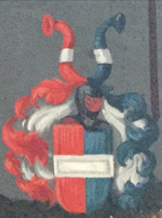
The Huettenbach main line already has gone out – the Huettenbach manor with its castle, which has been completed in 1760 and shows the same architectural style as Theuern castle, has firstly come to the Lochner of the Theuern branch in 1766, who, like their relatives in Lintach, continue to write themselves “of Huettenbach”. After the male descendants die out on Theuern in 1809, Hüttenbach passes to the repeatedly mentioned Christian Adam and Adam Frederick, belonging to the Lindenberg-Riegelstein branch. The latter two cousins are the direct descendants of the younger son of their ancestor Liborius: Christoph Louis Lochner of Huettenbach and his wife Sophia Louise Charlotta Pfreumdner of Bruck (May 30, 1688 – December 9, 1728).
Regarding Adam Frederick (1.3.1771 – 9.9.1825) it should be noted that he is a Royal Bavarian Chamberlain, Knight of the Civil Order of Merit of the Bavarian Crown, Government Director of the Lower Main District of the Chamber of the Interior, lives in Huettenbach and owns the estates in Riegelstein and Lindenberg. On August 16, 1797, Maria Anna Philippina of Redwitz at Redwitz (May 9, 1772 – November 28, 1858) has become his bride. In 1802 he receives an offer from Minister of Hardenberg to enter Prussian service. Mortgages are always made with his above-mentioned cousin Christian Adam in the years 1793, 1805 and 1817. Adam Frederick has three children, including two sons Christian Philipp Frederick Carl (July 31, 1808 – January 23, 1883) in his first marriage in 1833 with Catherine Schmidt (December 4, 1807 – October 2, 1848) and in his second marriage in 1851 to Anna Blaß (? – December 26, 1909), they will be the parents of the later last Lochner Josefph Simon living at Huettenbach manor. The second son Adam Joseph is also a royal Bavarian Chamberlain like his father, a retired postal worker, and the first owner of the estate in tail male in Lintach in Upper Palatinate, which has been established in 1823. He is also a long-time member of the Historical Association of Upper Palatinate and its regional capital of Regensburg. As already reported above, he has Justina Eva Catherine of Tannstein called Fleischmann as his wife. They have a total of six children – the couple has just moved to Huettenbach in 1865, diligently restoring the property as well as preparing the wonderful garden there.
The “most puzzling thing” is Christian Philipp and Adam Joseph’s sister: Sophie Amalie (?). Her brother Adam Joseph writes about her in his diary that “…in her early childhood years Bamberg has been occupied by the French under Napoleon,” and “…he and his sister must flee to their maternal grandparents to Redwitz”. From 1807 to 1809 she would have attended a girls‘ boarding school in Neuburg upon Danube, and during the years 1811/1812 she has lived with her grandmother in Bad Kissingen in Lower Franconia. Apparently, she then would have married a man named Theodor Ista on May 9, 1814, dying September 16, 1833 in Bamberg. She herself has lived with her daughter Fanny and passed away on February 4, 1877 in the age of 79.
Other sources state that she is the third wife of Imperial Count Maria Louis of Pestalozza (August 25, 1744 – 1821) on the manor of Mantel (a market town in Upper Palatinate district of Neustadt at Waldnaab, about 10 kilometers west of Weiden), who is a Palatine Bavarian Chamberlain, and already on February 2nd, 1817, she is said to have died in a very young age. 1790 – 1799 there has been a dispute between Franz Benno of Forster, forester at Pressath, and Maria Louis of Pestalozza regarding the sale of the Untermantel estate. And Imperial Count of Pestalozza asks for co-investment and desindent of his wife Sophie after the death of Carl Ludwig Lochner of Huettenbach at Lindenberg, which then will happen in the years 1797 – 1803[15].
The Counts of Pestalozza come from a long-established noble family of Italian origin in Bavaria.
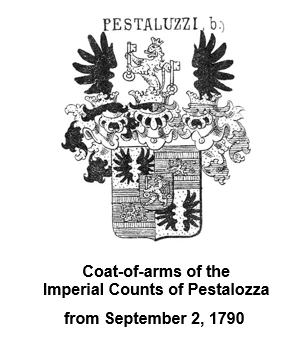
From the Website www.arcanum.com – see:
Kézikönyvatár / Siebmacher’s heraldic books / The Nobility of Hungary (Magyarország) / (Családok) / Pestaluz v. Pestaluzzi
It is said: this ancient family, also called Pestaluzzis, Pestalozza etc., comes from Graubuenden, died out in Austria-Hungary, and flourished or is still flourishing as a count in Bavaria.
Now regarding Adam Joseph’s other two sons:
the second son Anselm Eduard Joseph Justin Lochner of Huettenbach (February 10, 1831 – October 2, 1910) marries Sophie of Schlaegel (December 26, 1834 – August 5, 1902) on October 17, 1858. He is the founder of the currently thriving second line “Elten” (see family tree 5.2).
Anselm completes training at the Kulmbach postal and railway inspection in 1850, a year later in the same position at Amberg and from 1852 on in Wuerzburg. Eventually he has promoted to “post special cashier” in Fuerth, his career continues through Lindau at Lake Constance and Augsburg, where he has retired in 1892 due to a serious eye problem.

Signature of Prof. Oscar Lochner of Huettenbach
One of his sons, Prof. Dr. Oscar Lochner of Huettenbach (November 9, 1868 – July 8, 1920), attends elementary school in Fuerth and the Latin school in Lindau at Lake Constance, then afterwards the high school at St Stephan in Augsburg until 1887. He will than study philosophy and theology at the Royal Lyceums in Augsburg and Dillingen from 1888 to 1890, and finally finishes his theology studies in Munich and – even after his ordination to become priest in 1891 – he again gets his doctorate in history and art history.
In 1893 he receives this doctorate in art history under Berthold Riehl with a thesis on the Jesuit Church in Dillingen[16]. In 1893 he becomes a professor at the Eichstaett Episcopal Lyceum and has been giving lectures on history, art history and literature. He writes numerous local historical treatises and plays for Catholic popular theatres (pseudonym Max of Theuern). In the same year he is known as a supporter and member of the newly founded Catholic student association Akademia-Eichstaett in the KV from 1910, which will then be relocated to Wuerzburg under the name of “K.St.V. Rheno-Frankonia”. Oscar Lochner of Huettenbach is involved in these connections, writes celebratory speeches and designs the coat-of-arms of Rheno-Frankonia. In 1897/98 he is able to go on a study trip through Italy and Greece thanks to a half travel scholarship from the German Archaeological Institute for high school teachers.
It is noteworthy that he is connected to the family of King Louis III of Bavaria (House of Wittelsbach)[17].
His older brother, Maximilian Lochner of Huettenbach (September 16, 1859 – June 30, 1942), lives in Lindau at Lake Constance, is an agronomist and forester by profession, marrying Caroline van der Renne (January 27, 1862 – February 18, 1944) on May 23, 1882.
He is actively committed to the development of the city of Lindau and, for example, also provides land to build 16 apartments for the “customs colony”. He has left several art history and other historical writings from his private archive to the community archives. Maximilian Lochner of Huettenbach has written some large treatises about the history of Eltenberg and its church, as well as local historical essays on Lindau at Lake Constance. There he represents the Kingdom of Bavaria at the board of the Association for the History of Lake Constance and its surroundings.
In 1932, Elten (today part of the city of Emmerich upon Rhine) has granted him honorary citizenship and a street is named after him: “Von-Lochner-Straße” (German: “Of-Lochner-Street”)[18].
His descendants still live in the Lower Rhine are (see above) and in the Netherlands, but will die out in the foreseeable future (second line “Elten” – see family tree 5.2).
The fourth brother Christian Lochner of Huettenbach holds wedding with Gisella Maria Philomena Baroness of Beck-Peccoz and they have no children. “It was always fun with Uncle Christian and my aunt Gisella. My school days in Germany would be unthinkable without these two lovely people,” that is how their nephew Federico Baron of Beck-Peccoz describes his childhood when he has been sent from his home in Gressoney (Aosta Valley in Italy) to Bavaria. Today he is the Senior Manager of a large brewery near Augsburg, regularly visits Italy on vacation and has passed the reins to his juniors some time ago[19].-
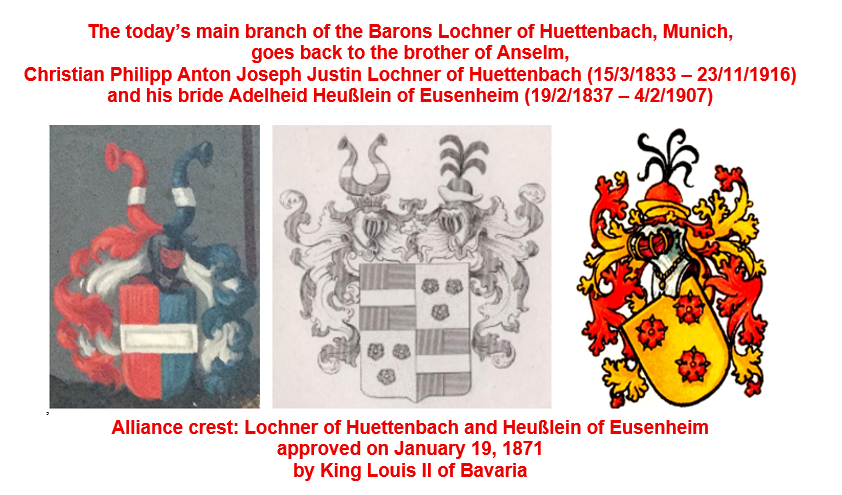
In 1871, the Lochner of Huettenbach’s name and coat-of-arms are united with this extinct baronial family of the Heußlein of Eusenheim from Bad Kissingen in Lower Franconia, after the marriage contract has been concluded on June 11, 1860. At this point, Christian is a Lieutenant in the 9th Infantry Regiment in Wuerzburg. On February 24th, 1866 he is transferred to the 2nd medical company because of a neck problem, and on July 23rd, 1866 to the 5th medical company. Afterwards he is appointed Captain 1st class on August 1st and on August 20, 1866 he is “commended before the enemy” for his behavior and on September 7th of the same year he has been transferred to the 3rd medical company. On October 11, 1870, he receives the Order of Military Merit for his achievements in the Battle of Sedan in the campaign against France. Already during the war, he has published in “Correspondents: Diary Sheets of a Person standing in the Field,” which he would have later published in a collected form in Nuremberg in 1871, and which arouses a lot of interest at those time. On January 19, 1871, he receives approval from the above-mentioned coat-of-arms association for himself and his descendants – personally approved by “Fairy Tale King” Louis II of Bavaria. His brother-in-law and comrade in the battle of Sedan, Carl Baron Heußlein of Eusenheim, the last male of his family, has died as a Chevauxlegers Lieutenant as a result of a succession ride near Sedan in France.
On June 25, 1872, Christian Lochner of Huettenbach retire and then live in the Castle of the nobles of Heußlein with his family in the city of Bad Kissingen. His wife and his daughters, like Marie (married to Louis of Fraunberg), Justine and Adele develop an important reputation as art embroiderers. Within the family they always talk about “Adele’s fairy hands” – the works have even been exhibited at the Munich Arts and Crafts Association.
Their younger brother Carl Joseph Philipp Maria Christian Adalbert Lochner of Huettenbach (November 5, 1868 – December 24, 1927) works as a General Practitioner and SPA doctor. Since he has died in 1927, the widow decides to move to Munich with her children. His son Eberhard of Lochner senior (October 11, 1910 – November 20, 1994) has continued to live there with his family and is a bank representative. Romantic piano music is his passion and he enjoys writing poems, which are published in 1978 by Majo Publishers for pictures and books at Bad Kissingen.
Senior Boss Baron Eberhard of Lochner junior, his son:
born in 1943, is married (two children and four grandchildren), has studied German language and literature studies, history and political science. He works as a teacher at the Graf-Rasso-Grammar School (German: Gymnasium) at Fuerstenfeldbruck near Munich, most recently as Director of studies. He has been releasing numerous publications on the life and work of the Historical Philosopher and founder of Political Science at the Ludwig-Maximilian-University in Munich named Eric Voegelin (1901-1985). He also has written lectures and essays on Thomas Mann and Wilhelm Hausenstein, as well as about Bavarian history of the 20th century. His affinity belongs to literature, especially poetry, which he prefers like his father.-
In Huettenbach after 1900, the extensive land that has belonged to the castle property of the Barons Lochner of Huettenbach is soon acquired by the Barons of Tucher at Simmelsdorf in the Nuremberg region, who have already bought Winterstein Castle from the Lochners after the Thirty Years‘ War. Because of debts, Colonel Joseph Simon Lochner of Huettenbach (February 9, 1857 – May 9, 1914), the last male of the Lochner family directly at Huettenbach, has not been able to preserve Huettenbach Castle, the seat of his ancestors, which they held for 378 years. So, in April 1906 his friend while hunting, the Frankfurt upon Main banker Rudolph Plochmann buys the manor.
After high school in Amberg, Joseph Simon, like his father, also completes the royal forestry school in Aschaffenburg. In military service he is most recently Colonel and Commander of the 15th Infantry Regiment in Neuburg at Danube, but shortly afterwards he has to retire due to a brain problem. His marriage to Sophie Christiana Hagen (born November 14, 1854) has left no descendants, so his branch extincts with him on May 9, 1914 in Nuremberg. The extensive castle archive, whose documents and files cover the period from 1400 to 1900 and which mainly consists of interest and balance books as well as fiefdom deeds, is sold by the castle owner, graduate engineer Director Plochmann, to the Nuremberg State Archives (today Repertory 311).
He and his heirs own Huettenbach Castle until 1934. On June 16th of this year the “Huettenbach Wandering and Local History Association” will acquire the castle. For security reasons, the owners now take the rest of the Lochner Archives to the Nuremberg State Archives. Henry Janz, the first Archivist at Huettenbach Castle, is owning a large part of the family records in the 1960s. Among others, he has been provided with a copy of the Lochner family history written by Maximilian Lochner of Huettenbach (see above – Elten line).
His granddaughter, Eleonore Cremers-of Lochner, who is really estimated by the website’s operator (unfortunately dying in 2016), and she has handed these documents over to her in the 1990s with Henry Janz’ words, once addressed to Eleonore:
“…one day someone will arrive and advance the study of the entire Lochner branches”.

E N C L O S U R E:
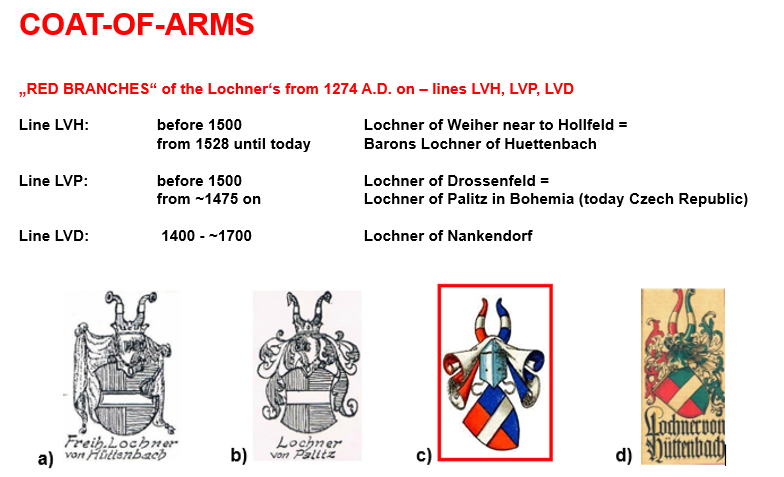

L I T E R A T U R E:
(in German language)


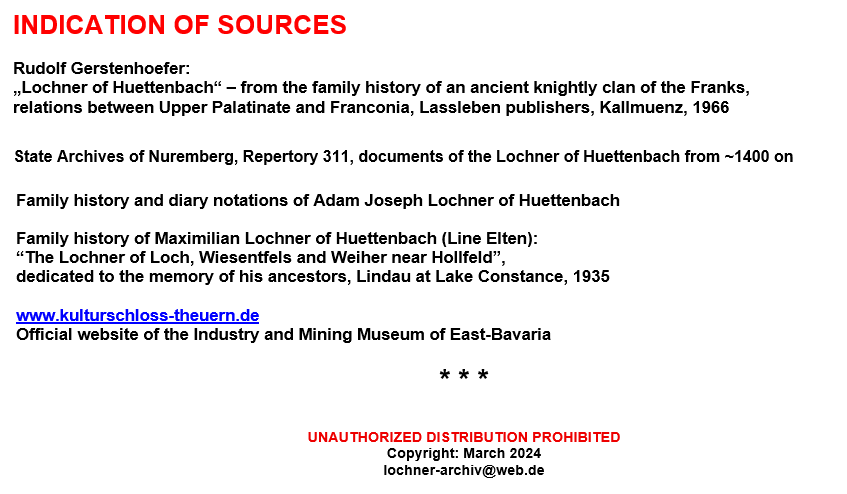
FOOTNOTES:
the books mentioned are in German language but the title of the books – as footnotes – are translated for a better understanding
-
Patronage law (lateinisch „ius patronatus“) „) = the patronage of a sovereign or landlord over a church that is located on his territory – Ansgar Hense / Florian Sepp: „Patronage law 19th/20th Century” – in: Historical Lexicon of Bavaria ↑
-
Estate in tail male = inalienable and indivisible genetic material – Rudolf Gerstenhoefer: ”Lochner of Huettenbach – from the family’s history of ancient Noble Frankish origin – the relationship between Upper Palatinate and Franconia”, Lassleben Publishers, Kallmuenz, 1966 ↑
-
Coat-of-arms of the Zollner of Brand: Horst Appuhn (Editor): „John Siebmacher’s heraldic book. Frankish 107. The bibliophile paperbacks 538”, 2nd improved edition, Dortmund, 1989 ↑
-
Michael Diefenbacher: „Zollner of Brand, A Patrician family“, in: Michael Diefenbacher, Rudolf Endres (Editors): „City Lexicon of Nuremberg“, 2nd improved edition, W. Tuemmels Publishers, Nuremberg, 2000 ↑
-
Coat-of-arms of the Barons of Podewils – by SVG: Depthfield – de.wikipedia.org, picture-PD-old, https://de.wikipedia.org/w/index.php?curid=8372437 ↑
-
In 1972, the Amberg-Sulzbach district of Upper Palatinate founded the supra-regional Mining and Industrial Museum of Theuern and it opened in 1978. Its most important task is to research, document and present the mining and industry of the entire Eastern Bavarian region ↑
-
Community chronicle of Theuern: Essay about “The Theuern Castle buildings up to the beginning of the 19th century”, p. 252 ↑
-
that is to be said on the Website of the Mining and Industrial Museum of Eastern Bavaria on Theuern Castle – www.kultur-schloss-theuern.de ↑
-
Coat-of-arms of the Barons of Bibra – painting of Adolph Matthew Hildebrandt ↑
-
William Baron of Bibra: “History of the Noble family of the Barons of Bibra“, 1870 – Werner Wagenhoefer: „The Bibra‘s: “Studies und Materials about genealogy and history of the possessions of a Franconian Noble family of Baron class in the late middle ages“, Degener & Co Publishers, Neustadt/Aisch, 1998 ↑
-
Christoph Louis Lochner of Huettenbach buys the Riegelstein manor from John Christoph of Varell for 10,000 fl. and 300 fl. key money. It is awarded in 1766 to Carl Ludwig and Rudolph Henry, in 1773 to Carl Derrick, in 1779 to Carl Louis, Carl Derrick and Joseph Christian, and in 1794 to Christian Adam, Carl Louis and Adam Frederick ↑
-
Photography from the book: “850 years of Huettenbach- history of a village” – Editors: Volker Alberti – Horst Gebhard – Perry Gumann ↑
-
Carl Christian of Mann called Tuechler- in: New obituary of the Germans, 15th year, 1837, part 1, Voigt, Weimar, 1839, p. 387 f. ↑
-
Sale of the estate of Untermantel: State Archives of Amberg, Princedom of Palatinate-Sulzbach, Government, records of Weidau 1247 and Weiden Office 1538, Princedom of Palatinate-Sulzbach, Government, records of Weidau 29/412 – Request for co-incumbency for his wife Sophie Lochner of Huettenbach: StA BA B58/III, no. 05737 and StA BA B58/III,no. 05746 ↑
-
Oscar Lochner of Huettenbach: “The Jesuit Church in Dillingen. Their history and description with special attention to the master of their frescoes, Christoph Thomas Scheffler (1700–1756). A contribution to the art history of the 17th and 18th centuries”, Stuttgart, 1895 (= Dissertation of 1893) ↑
-
Ferdinand Vonwerden: „Oscar Baron Lochner of Huettenbach“, in: Collection sheet of the Historical Association Eichstaett 35, 1920, p. 17 – 21 -Siegfried Koß, Wolfgang Loehr (Editors): „Biographical Lexicon of KV, part 7 (= Revocatio historiae)“, vol. 9, Akadpress Publishers, Essen, 2010, p. 88 ff. ↑
-
Harald Derschka: „The Association for the History of Lake Constance and its surroundings. A look back at one hundred and fifty years of the club’s history 1868 – 2018“, in: Writings of the Association for the History of Lake Constance and its surroundings, 136, 2018, p. 1 – 303, here: page 220
-
Mail to the authoress from Federico Baron of Beck-Peccoz dated October 20, 2023 ↑